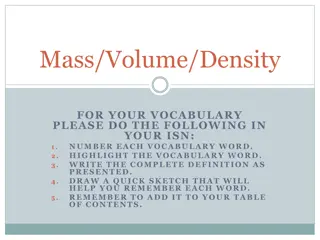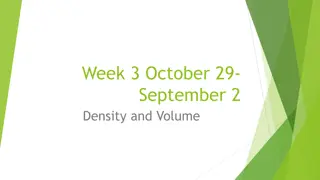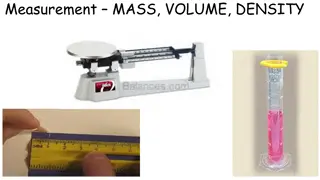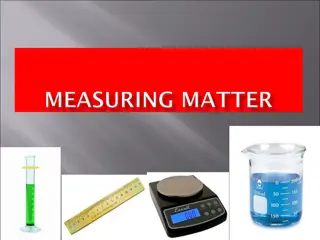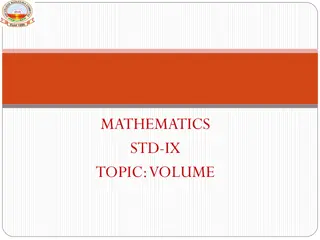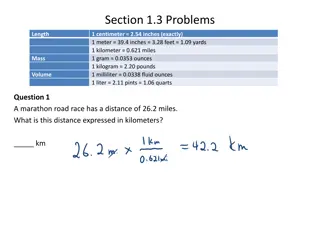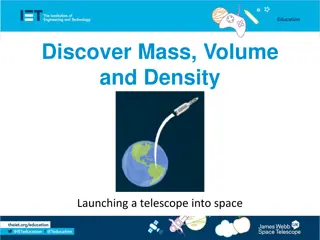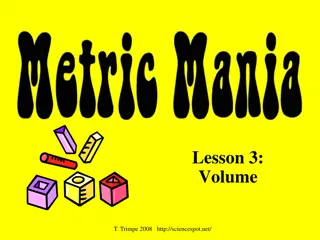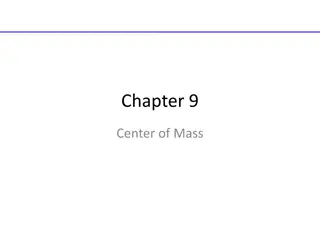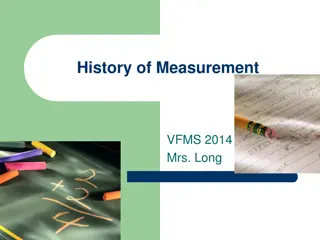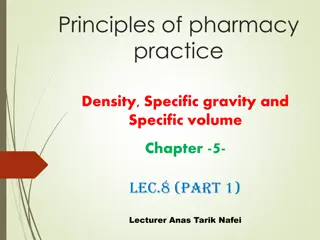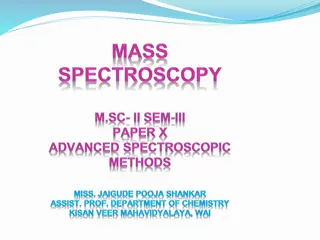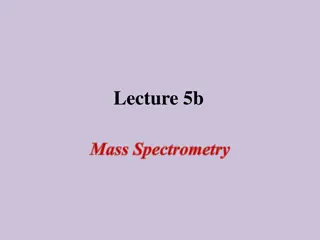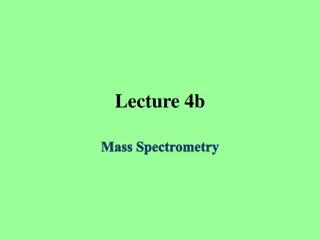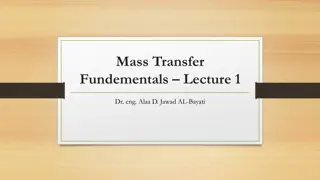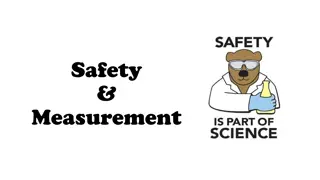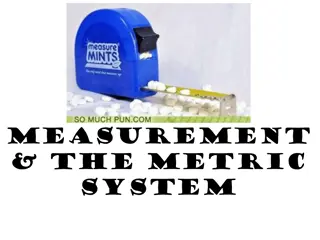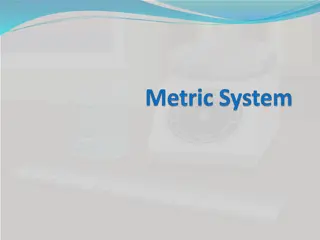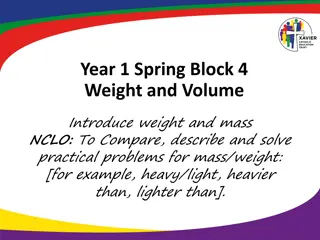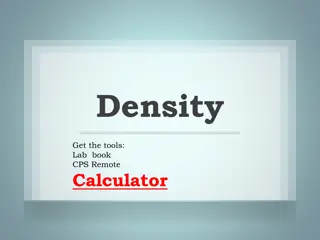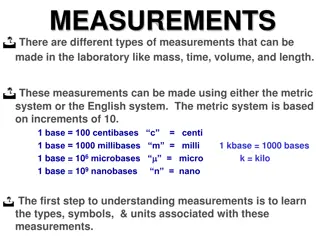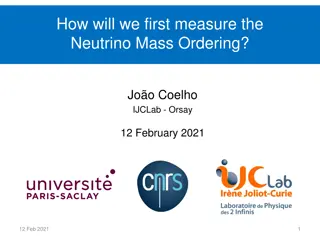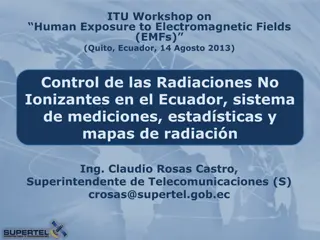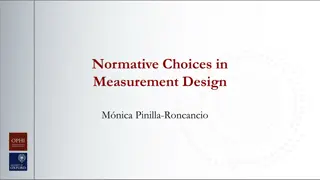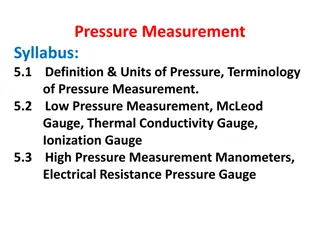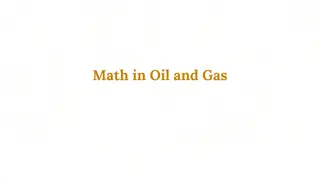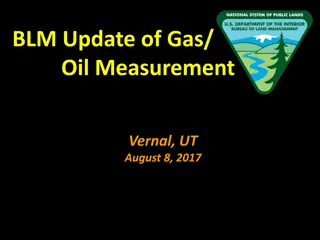Exploring Mass and Volume in Measurement Activities
Explore and measure mass of objects and liquid volume in lesson activities. Understand comparing grams and kilograms, milliliters and liters. Practice solving problems involving volume and mass estimation. Engage in cooperative pairs to work on mass comparisons. Enhance skills in multiplication by 10.
Uploaded on Oct 01, 2024 | 0 Views
Download Presentation

Please find below an Image/Link to download the presentation.
The content on the website is provided AS IS for your information and personal use only. It may not be sold, licensed, or shared on other websites without obtaining consent from the author. Download presentation by click this link. If you encounter any issues during the download, it is possible that the publisher has removed the file from their server.
E N D
Presentation Transcript
Lesson 20 Measure and Estimate Mass of Objects and Liquid Volume
[OBJECTIVE] The student will explore, calculate, measure and estimate mass of objects and liquid volume using standard units of grams, kilograms, liters, and milliliters.
[MYSKILLS] Multiplication by 10
[ESSENTIALQUESTIONS] 1. How can I compare grams and kilograms? 2. How can I compare milliliters and liters? 3. What would be an appropriate unit of measure to estimate the mass of a large dog? Why?
SOLVE Dontae s mom volunteered to help with the class party at the end of the year. There are 28 students in his class. Dontae s mom is buying 1 liter bottles of fruit punch for the drink. If she plans on 4 servings per liter, how many liters of fruit punch does she need? S Study the Problem Underline the question. This problem is asking me to find the number of liters of fruit punch she needs.
[Cooperative Pairs] Partner A Partner B
Working with Mass Which cube would have the greater mass? The LARGE cube
Working with Mass How many of the small unit cubes do you think will fit inside the large unit cube?
Working with Mass How many small cubes do you think it will take to cover the bottom of the large cube? 100
Working with Mass How many small unit cubes tall is the large unit cube? 10 small unit cubes tall
Working with Mass If there are 100 small unit cubes in one layer of the large unit cube, how many layers of 100 small unit cubes would it take to fill the large unit cube? 10 layers
Working with Mass How many small unit cubes are needed to fill the large unit cube if the small unit cubes filled it to the top. 1,000 small unit cubes
Working with Mass Mass is the amount of space in an object. In order to measure mass, we will call the small unit cube a gram. = 1 gram How many grams will fit in the large unit cube? 1,000 The large unit cube with 1,000 grams represents a kilogram!
Working with Mass Which has the larger mass: 1 gram or 1 kilogram? 1 gram 1 kilogram
Working with Mass How many grams does it take to cover the bottom of the kilogram container? 100 grams
Working with Mass How many grams can be stacked in the corner to determine the height? 10 grams
Working with Mass How many grams does it take to completely fill the kilogram container? 1,000 grams
Working with Mass How many grams equal 1 kilogram? 1,000 grams
Working with Mass Mass is the amount of space in an object. It is measured in grams and kilograms. What are some objects you see every day that would be measured using grams? A slice of bread A piece of paper What are some objects you see every day that would be measured using kilograms? A dog A backpack
Working with Mass What would be the most appropriate unit for measuring the mass of a pencil? The gram would be most appropriate because it is used to measure smaller amounts of mass.
Working with Mass What would be the most appropriate unit for measuring the mass of a textbook? The kilogram would be most appropriate because it is used to measure larger amounts of mass.
Working with Mass About 1 kilogram About 1 gram Exactly 1 gram Exactly 1 kilogram Do you know the exact mass of the loaf of bread? No, because there are no marks to show the measurement. Decide what would be the most accurate measurement unit for the loaf of bread.
Working with Mass About 10 kilograms About 10 grams Exactly 10 grams Exactly 10 kilograms Key: Each mark equals 1 gram Do you know the exact mass of the sand in the container? Yes, because there is a container with marks showing the amount and a key to tell us how much each mark represents.
Working with Mass About 10 kilograms About 10 grams Exactly 10 grams Exactly 10 kilograms Key: Each mark equals 1 gram Decide what would be the most accurate measurement for the container of sand.
Working with Mass The box below is full of sand. It has a mass of 10 kilograms.
Working with Mass John has 5 boxes full of sand. If each of the boxes has a mass of 10 kilograms, what is the total mass of the 5 boxes? 50 kilograms
Working with Mass The box below is full of sand. It has a mass of 15 kilograms. If Kate has 2 boxes, what is the total amount of sand she has? 30 kilograms What is the difference between the amounts of sand John and Kate have? 50 30 = 20 kilograms
Working with Mass In the last activity, the small unit was 1 gram and the larger unit was 1 kilogram. 1 gram 1 kilogram
Working with Volume In the next activity, the small unit will represent a milliliter, and the large unit will represent a liter. 1 milliliter 1 liter
Working with Volume Which has the greater volume: 1 milliliter or 1 liter? 1 milliliter 1 liter
Working with Volume How many milliliters does it take to cover the bottom of the liter container? 100 milliliters
Working with Volume How many milliliters can be stacked in the corner to determine the height? 10 milliliters
Working with Volume How many milliliters does it take to completely fill the liter container? 1,000 milliliters
Working with Volume How many milliliters equal 1 liter? 1,000 milliliters
Working with Volume Volume is the amount of space the liquid occupies. It is measured in milliliters and liters. Discuss some liquid volumes you see every day that would be measured in milliliters. Water in a teaspoon Bottle of hand lotion Discuss some liquid volumes you see every day that would be measured in liters. Carton of milk Gasoline for a car
Working with Volume What would be the most appropriate unit for measuring the volume of the liquid in the glass? The milliliter would be most appropriate because it is used to measure smaller volumes.
Working with Volume What would be the most appropriate unit for measuring the volume of the liquid in the water can? The liter would be most appropriate because it is used to measure larger volumes.
Working with Volume About 1 liter About 1 milliliter Exactly 1 milliliter Exactly 1 liter Do you know the exact volume of juice in the carton? No, because there are no marks to show measurement. Decide what would be the most accurate measurement for the juice in the carton.
Working with Volume About 10 liters About 10 milliliters Exactly 10 milliliters Exactly 10 liters Key: Each mark equals 1 milliliter Do you know the exact volume of the water in the container? Yes, because there is a container with marks showing the amount and a key to tell us how much each mark represents.
Working with Volume About 10 liters About 10 milliliters Exactly 10 milliliters Exactly 10 liters Key: Each mark equals 1 milliliter Decide what would be the most accurate measurement for the volume of the water in the container.
Working with Mass The container below is filled with water. It has a volume of 1 liter.
Working with Mass Sara has to fill 4 containers with water for a science lab. If each container has a volume of 1 liter, what is the volume of the 4 containers? 4 liters
Working with Mass Karissa is working on a different science lab. The amount of water she needs is shown below. Identify the volume of the container. 3 liters What is the difference between the volume of water Sarah is using and the volume of water Karissa is using? 4 3 = 1 liter
SOLVE Dontae s mom volunteered to help with the class party at the end of the year. There are 28 students in his class. Dontae s mom is buying 1 liter bottles of fruit punch for the drink. If she plans on 4 servings per liter, how many liters of fruit punch does she need? S Study the Problem Underline the question. This problem is asking me to find the number of liters of fruit punch she needs.
Dontaes mom volunteered to help with the class party at the end of the year. There are 28 students in his class. Dontae s mom is buying 1 liter bottles of fruit punch for the drink. If she plans on 4 servings per liter, how many liters of fruit punch does she need? O Organize the Facts Identify the facts. Eliminate the unnecessary facts. List the necessary facts. 28 students 4 servings per liter
L Line Up a Plan Choose an operation or operations. Division Write in words what your plan of action will be. Divide the number of students by the servings per liter.
V Verify Your Plan with Action Estimate your answer. Less than 10 liters Carry out your plan. 28 4 = 7 7 liters
E Examine Your Results Does your answer make sense? (compare your answer to question.) Yes, because I am looking for the number of liters of fruit punch. Is your answer reasonable? (compare your answer to the estimate.) Yes, because it is close to my estimate of less than 10 liters.
Is your answer accurate? (check your work.) Yes. Write your answer in a complete sentence. Dontae s mom needs 7 liters of fruit punch.
[ESSENTIALQUESTIONS] 1. How can I compare grams and kilograms? (There are 1,000 grams in 1 kilogram.)



